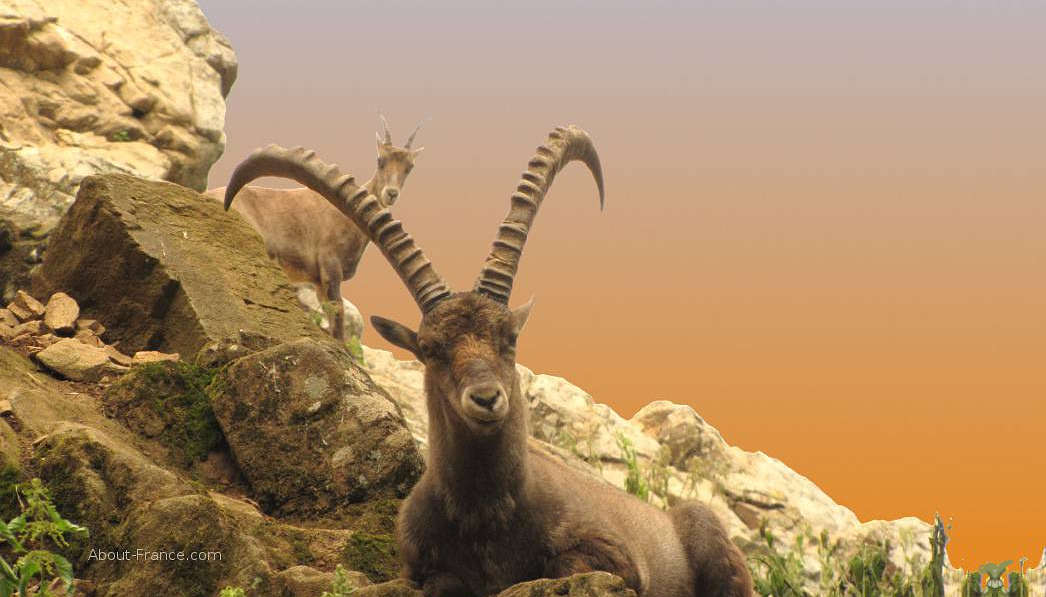
Wildlife in France
A short guide to the fauna of France
- Explore France ►
- Essential pages
- Travel in France
- Where to go
- What to see and do
About-France.com
- the connoisseur's guide to France
A short guide to wildlife in France
| Go to ► | Animals and insects |
Birds |
| Flowers | Wildlife reserves |
For wildlife enthusiasts, parts of France are an open book waiting to be explored. Thanks in part to the French Revolution and in part to the much decried European Common Agricultural Policy, much of the French countryside remained fairly backward in terms of agricultural progress during the twentieth century, a land farmed in traditional ways by smallholders practising diversity. This maybe left much of French agriculture less productive than the big agribusiness concerns of North America or even Britain, but it also left many parts of France's rural environment more intact, and its wildlife more diverse.
While some species inevitably died out in the wild, such as bears and wolves, others such as wild boar, chamoix, martens and red squirrels, peregrine falcons and hen harriers, have survived and are henceforth protected - though not threatened - species. In areas that have been spared the ravages of industrial-scale agriculture, insect life and plant life remain rich and abundantant. And while it is true to say that wildlife diversity is not all that it used to be in many parts of France, there are other areas, specially in the hills of the southern half of France, where wildlife thrives as it always has done. Indeed, some species that had almost died out have reappeared or been reintroduced with varying degrees of success: griffon vultures in the Massif Central and the Pyrenees, bears in the Pyrenees, wolves in the Alps and possibly in the Massif Central, lynxes in the Jura, marmots in the Massif Central ...
Animals, mammals

Marmots can be seen (and heard) at many locations in the French Alps, Pyrenees and high Massif Central
The list of French mammals below is far from exhaustive; it covers the larger and most interesting species. In addition to the species listed below, France also is home to badgers, foxes, otters, rats, mice, rabbits and hares, red squirrels, and even - but only in the Rhine valley - wild hamsters. As for brown bears and wolves, they remain extremely rare in the areas where they have been reintroduced - wolves in the high Alps, bears in the Pyrenees. Visitors are unlikely to see them, and are not encouraged to go looking for them.
 |
Alpine ibex (photo top of page) | Known as bouquetins in French, these fine mountain ibex have recolonised parts of the French Alps, partly naturally from Italy, partly through reintroduction. Today there are about 9000 of them, mostly living in the higher parts of the Alps, and especially in the Vanoise national park. |
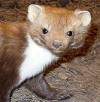 |
Beech marten | Called "fouines" these are fairly common in most parts of rural France; they often live near or in houses and are sometimes considered a nuisance as they seem to enjoy eating electric cables and loft insulation material. |
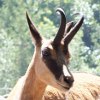 |
Chamois | The chamois or mountain goat is considered as one of the emblematic animals of the Alps in general. In France, it can be found not just in the Alps, but also in the Jura in Franche Comté, the southern Vosges mountains, and the high parts of the Massif Central. Chamois can come down to quite low altitudes, well below 800 metres. |
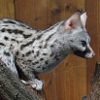 |
Common Genet | The common genet, called la genette in French, unknown in Britain, is a small carnivorous mammal found notably in the southwest quarter of France, south of the Loire and west of the Rhone. A nocturnal species, it is not an animal that has much contact with humans. |
 |
Dormice | Large dormice, known in French as Loirs, and often popularly called glis glis, are relatively widespread in rural France, except near the Atlantic; but they are not common. They live in wooded areas, but may make their homes in country cottages or farm buildings |
 |
European beaver | Les Castors can be found in many French rivers, notably in the Loire and Rhone and some of their tributaries, including the Indre, the Cher, the Allier, the Isère, the Doubs as well as in the Moselle. |
| Lynx | The lynx is a spotted member of the cat family, about twice the size of a domestic cat. Lynxes are very shy animals and do not like to be seen. They are rare - there are only about 200 individuals, living in the Vosges, the Jura and the Alps. The largest concentration is in the Jura, where they have reestablished themselves naturally, moving in from Switzerland. | |
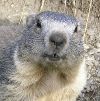 |
Marmots | Marmots, les marmottes, are another emblematic animal of the Alps. These large rodents live underground, at altitudes between 800 and 3000 metres, in the Alps, the Pyrenees and the Massif Central; they come out in daytime, and can sometimes be seen by hikers and climbers. |
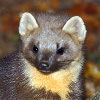 |
Pine marten | Pine martens, known as "martres" in French, can be found in most regions or Fance, but they are most commonly found in the forested areas of Brittany, the Massif Central, Burgundy, Alsace, Lorraine and the Jura. They tend to live in woodland, far from human activity. |
 |
Polecats | The elusive polecat or "putois" is not common, but can be found almost all over France, though not so much in the Alps. This relative of the otter and the domestic ferret is a nocturnal animal that prefers humid areas; it lives essentially off frogs and small mammals. |
 |
Red deer | Red deer, des cerfs (male) and biches (female), can be found in most of the forested areas of France. This includes the east of France, the Loire valley, the Massif Central, Brittany and the Pyrenees. The total population in 2013 is estimated at about 165,000. |
| Racoon | This North-American is not native to France; however, a number of "coons" came over to France as mascots, with US soldiers in the two world wars, and some escaped. they have also come in from Germany, where they were introduced in the 1930s. After very slow development, the species is now becoming well established along some valleys in Eastern and central France. | |
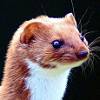 |
Weasels | Known in French as "belettes", these are particularly common in northwestern regions of France, notably Britanny, Normandy and the Loire Valley; however they can be observed throughout France |
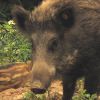 |
Wild boar | Wild boar, called sangliers, can be seen in most parts of rural France. There are an estimated two million wild boar in France in 2013, living mostly in areas of mixed land use - agriculture and woodland. Never approach a wild boar, and specially not a wounded one. |
| Wolf | Wolves used to be extinct in France; but today there are estimated to be some 300 wolves in France. Wolves first reappeared in the Alps, moving over naturally from Italy, where they were never extinct. Today some have crossed the Rhone, and have been spotted in the Haute Loire department of the Auvergne |
Insects :
Rural France is very rich in insect life, notably in those areas that have never been much affected by intensive agriculture. This means the upland areas of southern France and eastern France, notably the Massif Central, the Morvan, the Jura, Lorraine and the Vosges. In many places in these parts of France, the wealth of insect life can be seen by the number and variety of butterflies.Among the best known and best loved insects of France are the cricket, or cri-cri in French, and the cigale or cicada. Crickets and cigales are the insects that bring a countryside to life, specially in the evening, with their constant chirping. Crickets are found in most of the southern half of France; cigales, with a much more strident chirping, are associated with, and most common in, areas around the Mediterranean. However other varieties of cigales are found in western France and in mountainous areas of France.
Other insects that can often be found in more rural parts of France include a wide variety of bees, wasps and beetles, as well as large green grasshoppers - up to two inches long - and the praying mantis. In southern France, large metallic-green scarab beetles are not rare.
Reptiles and amphibians
 A salamander - these
nocturnal amphibians are rare and protected, but live in most parts of
France
A salamander - these
nocturnal amphibians are rare and protected, but live in most parts of
France Where to see wildlife in France
Obviously, wildlife can be seen all over France... even in the middle of Paris or in the densely populated former industrial areas of the northeast. But not surprisingly, most parts of France have witnessed a decline - even a sharp decline - in wildlife over the past fifty years, due to intensive agriculture, habitat loss, pesticides, and encroaching urbanisation. But some regions have fared more favourably in wildlife terms than others. Today the areas of France with the best wildlife tend to be those with the least human activity – which means the poorer upland areas of eastern France and southern France, where agriculture has remained more traditional and less intensive, and there are large areas of woodland. The map, left, shows the "diagonale du vide", the sparsely populated band that runs from central eastern France down to the southwest, and includes the higher areas of Lorraine and Burgundy, and in particular the Massif Central uplands of southern France.Nature reserves
France has many nature reserves, in particular bird sanctuaries. The core areas of France's National Parks, in the Alps , the Pyrenees and the Cévennes, are biosphere reserves where nature is allowed to develop naturally. Many of France's almost 50 regional parks are, or contain, wildlife sanctuaries, notably bird sanctuaries. For more information on national parks and regional parks in France, see Wild France.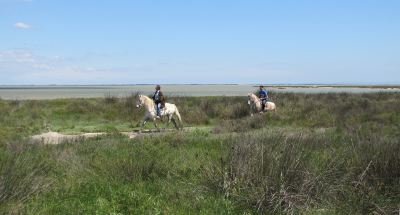 Riding
across the Camargue wetlands
Riding
across the Camargue wetlands Going further:
- Off the beaten track - undiscovered France
- information and a map of France's long-distance footpaths
- Camping in France
- The Massif Central
- The Pyrenees,
- The best of rural France - Eight rural departments away from the tourist hordes
- Undiscovered Spain
About-France.com
Home
page - Site
search
- Regions
- Maps of France
- Contact
The
Alpine Ibex, or Bouquetin, has made an impressive comeback in the high
parts of the French Alps.
Photo © About-France.com
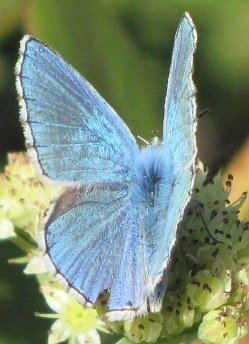
The osiris blue, one of the colourful butterflies abundant in some parts of rural France
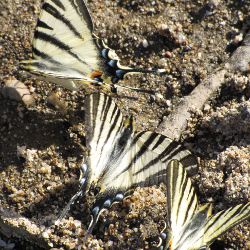
Cluster of swallowtail butterflies beside a stream in the Auvergne
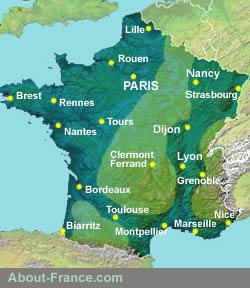
Empty France - the diagonal of sparsely populated areas, where wildlife is particularly abundant
The text and photos on this page are copyright About-France.com
except vignettes 2 and 4-12 which are published under the creative commons licence. Photographers F.Atirador, , N.Guérin, B Clauss, M.Malipeddi, F. Trazzi, D. Kropivinik, P Trimming, M Bigge, K Law, and About-France.com
Photo © About-France.com

The osiris blue, one of the colourful butterflies abundant in some parts of rural France

Cluster of swallowtail butterflies beside a stream in the Auvergne
| Accommodation in France |
| Gites and holiday cottages |
| Bed and breakfast in France |
| Small rural campsites in France |
| Small "green" hotels in France |

Empty France - the diagonal of sparsely populated areas, where wildlife is particularly abundant
The text and photos on this page are copyright About-France.com
except vignettes 2 and 4-12 which are published under the creative commons licence. Photographers F.Atirador, , N.Guérin, B Clauss, M.Malipeddi, F. Trazzi, D. Kropivinik, P Trimming, M Bigge, K Law, and About-France.com
An
independent website, About-France.com is an affiliate partner of
selected external websites,
and may receive a small commission on sales generated after users click
through to a partner site.

